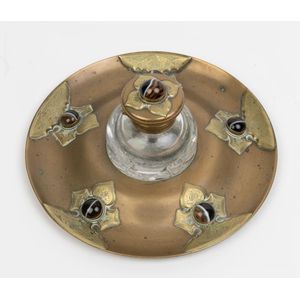A Victorian brass Arts and Crafts inkwell, possibly Scottish,…
A Victorian brass Arts and Crafts inkwell, possibly Scottish, circa 1870, with banded agate cabochons, 24 cm diameter
You must be a subscriber, and be logged in to view price and dealer details.
Subscribe Now to view actual auction price for this item
When you subscribe, you have the option of setting the currency in which to display prices to $Au, $US, $NZ or Stg.
This item has been sold, and the description, image and price are for reference purposes only.
- Art and Crafts Movement - The Arts and Crafts movement began in Britain around 1880 and quickly spread across America and Europe. The Movement took its name from the Arts and Crafts Exhibition Society, founded in London 1887. One of the most influential figures behind the Arts and Crafts movements was the designer and writer William Morris. The movement continued until about 1920 and was followed by the Art Deco movement.
- Circa - A Latin term meaning 'about', often used in the antique trade to give an approximate date for the piece, usually considered to be five years on either side of the circa year. Thus, circa 1900 means the piece was made about 1900, probably between 1895 and 1905. The expression is sometimes abbreviated to c.1900.
- Agate - Agate is a type of semi-precious gemstone that is made up of silica dioxide, a mineral that is also found in quartz. It is known for its distinctive banded patterns, which are created as layers of silica are deposited in different colours including red, orange, yellow, green, blue, and purple. It is often used in jewellery, decorative objects, and other decorative items, and it is prized for its beauty and durability. Agate is found in many parts of the world, including Brazil, India, and the United States.
- Victorian Period - The Victorian period of furniture and decorative arts design covers the reign of Queen Victoria from 1837 to 1901. There was not one dominant style of furniture in the Victorian period. Designers used and modified many historical styles such as Gothic, Tudor, Elizabethan, English Rococo, Neoclassical and others, although use of some styles, such as English Rococo and Gothic tended to dominate the furniture manufacture of the period.
The Victorian period was preceded by the Regency and William IV periods, and followed by the Edwardian period, named for Edward VII (1841 ? 1910) who was King of the United Kingdom and the British Dominions and Emperor of India for the brief period from 1901 until his death in 1910.
This item has been included into following indexes:
